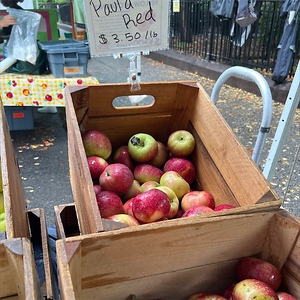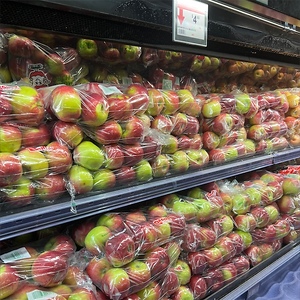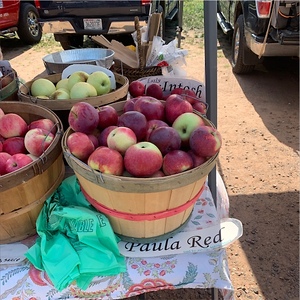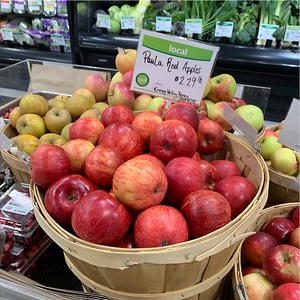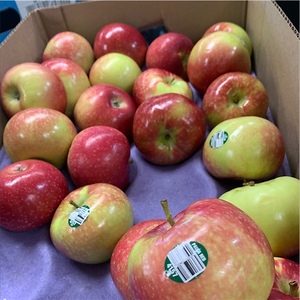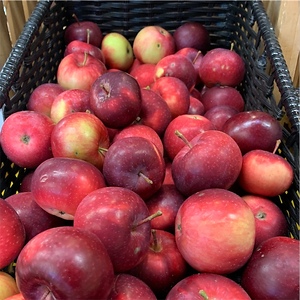

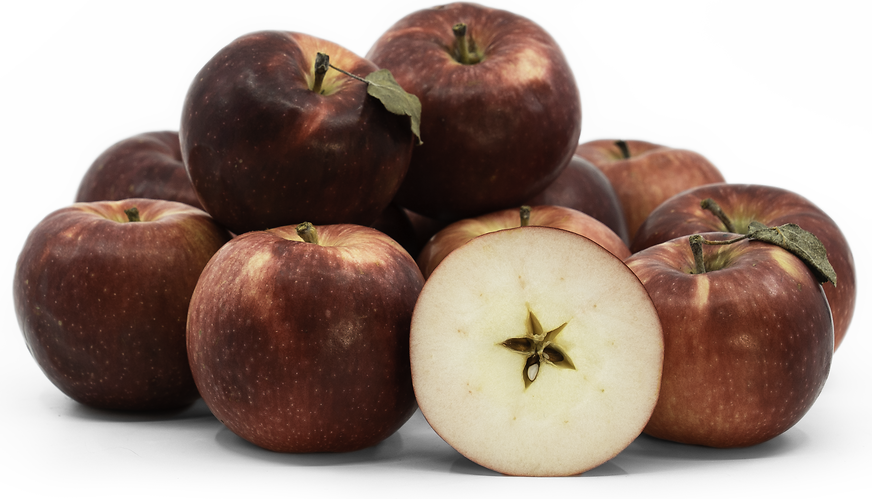
Paula Red Apples
Estimated Inventory, lb : 0
Description/Taste
Paula Red apples are a medium to large varietal with a round to ovate shape, bearing flattened shoulders and a squat appearance. The apple’s skin is thick and chewy with a yellow-green base coloring, almost entirely covered in bright red blush and striping. The surface also has a matte appearance and sometimes showcases a dusty overlay, giving the apples a faded color scheme. Underneath the surface, the white to ivory flesh is aqueous, firm, and crisp, encasing a small central core filled with tiny black-brown seeds. Early in the season, Paula Red apples have a firm and crunchy consistency, but the flesh softens at the end of the season, becoming slightly mealy. Paula Red apples have a bright, generally balanced sweet-tart taste with subtle fruity nuances reminiscent of strawberries and pears. The apples may also have a tarter and tangier flavor profile, depending on the time in the season when the fruits are harvested.
Seasons/Availability
Paula Red apples are available in the late summer through mid-fall.
Current Facts
Paula Red apples, botanically classified as Malus domestica, are an early-season variety belonging to the Rosaceae family. The apples were discovered naturally growing in an orchard in Michigan in the late 20th century and are one of the earliest varieties to ripen in the Eastern United States. Paula Red apples grow on compact trees that reach up to five meters in height, and enthusiasts favor the apples for their sweet-tart flavor. The variety was named after the discovering farmer’s wife, Pauline, and is a multi-purpose apple suitable for fresh and cooked preparations. Paula Red apples will change in texture and consistency throughout the season and have become a boutique variety sought after in the late summer to early fall.
Nutritional Value
Paula Red apples are a good source of fiber to regulate the digestive tract and potassium to balance fluid levels within the body. The apples also provide vitamin C to strengthen the immune system, vitamin E to protect the cells against free radical damage, vitamin K to assist in faster wound healing, and vitamin A to maintain healthy organ functioning. Beyond vitamins, the apples contain lower amounts of magnesium, iron, calcium, phosphorus, zinc, and copper.
Applications
Paula Red apples have a sweet-tart flavor well suited for raw and cooked preparations. The apples are best consumed raw early in the season, as the freshly picked fruits have a crisper, firmer consistency. Paula Red apples can be eaten straight, out of hand, chopped into slaws and fruit bowls, or sliced into salads. The flesh oxidizes slowly, allowing the fruits to be displayed on cheese boards, dipped into chocolate or caramel, or layered over toast with nut butter. Later in the season, Paula Red apples develop a mealy, softer consistency suitable for several cooked preparations. The apples can be incorporated into crisps, cobblers, and crumbles, baked into scones, muffins, granola bars, and pancakes, or combined with firmer apple varieties in fillings for pastries. Paula Red apples can also be simmered into apple butter, a thick sauce-like topping for waffles and ice cream, or cooked into applesauce, requiring little to no added sugar. It is important to note that the soft apples will not hold their shape with cooking, so recipes for this variety should be selected that require the apples to be broken down into pastes and sauces. Beyond fresh and cooked preparations, the apples can be sliced into rings and dried for extended use. Paula Red apples pair well with spices such as ginger, nutmeg, cloves, allspice, and cinnamon, dried fruits including cherries, cranberries, and raisins, nuts such as walnuts, pecans, and pine, sweet potatoes, and meats such as beef, pork, and turkey. Whole, unwashed Paula Red apples have a short shelf life and will only keep for a few weeks when stored in a cool, dry, and dark place such as the refrigerator. The apple's texture will also change with time, transitioning from firm and crisp to mealier and soft with storage.
Ethnic/Cultural Info
Paula Red apples were discovered growing in a unique region in Michigan known as the Fruit Ridge, or simply “The Ridge.” The Fruit Ridge is a geographical region that spans approximately twenty miles long and eight miles wide and was developed from ancient glaciers. These glaciers created rolling hills, which gave the area a distinct climate and rich soil ideal for fruit production. The Fruit Ridge produces over half of Michigan’s apples and is considered one of the best places for apple cultivation within the state. The farms situated in the Fruit Ridge are also diversifying their business by constructing restaurants, wineries, and breweries to promote agritourism. The farms are using their unusual location as a weekend destination, and by creating facilities that can host events, parties, and tours, more visitors are venturing to the Fruit Ridge. In the late summer, many Michigan residents also visit the Fruit Ridge to participate in U-pick orchard experiences. Paula Red apples are easy-to-harvest, and the variety has become a locally famous seasonal apple favored for its sweet, tart, and tangy flavor.
Geography/History
Paula Red apples were discovered as a chance seedling growing in an orchard in Sparta, a village within the county of Kent, Michigan. The apple’s parentage is unknown, but the variety was growing near a field of mcintosh apples, leading many pomologists to believe it may be one of the apple's parents. Paula Red apples were selected for propagation by grower Louis Arends in 1960 and were later released to the public in 1968. Today Paula Red apples are an early-season variety favored throughout the Midwest and the Northeastern United States. The apples are not commercially cultivated due to their short shelf life, but they are popular in home gardens and among apple orchards in Michigan. When in season, Paula Red apples are available in local markets, select grocers, and farm stands.
Recipe Ideas
Recipes that include Paula Red Apples. One
| Pie Lady Bakes |
|
Apple Pie Coffee Cake |
| More Sweets Please |
|
Apple-icious Pie |



